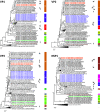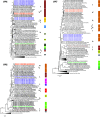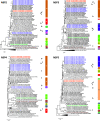At Least Seven Distinct Rotavirus Genotype Constellations in Bats with Evidence of Reassortment and Zoonotic Transmissions
- PMID: 33468689
- PMCID: PMC7845630
- DOI: 10.1128/mBio.02755-20
At Least Seven Distinct Rotavirus Genotype Constellations in Bats with Evidence of Reassortment and Zoonotic Transmissions
Abstract
Bats host many viruses pathogenic to humans, and increasing evidence suggests that rotavirus A (RVA) also belongs to this list. Rotaviruses cause diarrheal disease in many mammals and birds, and their segmented genomes allow them to reassort and increase their genetic diversity. Eighteen out of 2,142 bat fecal samples (0.8%) collected from Europe, Central America, and Africa were PCR-positive for RVA, and 11 of those were fully characterized using viral metagenomics. Upon contrasting their genomes with publicly available data, at least 7 distinct bat RVA genotype constellations (GCs) were identified, which included evidence of reassortments and 6 novel genotypes. Some of these constellations are spread across the world, whereas others appear to be geographically restricted. Our analyses also suggest that several unusual human and equine RVA strains might be of bat RVA origin, based on their phylogenetic clustering, despite various levels of nucleotide sequence identities between them. Although SA11 is one of the most widely used reference strains for RVA research and forms the backbone of a reverse genetics system, its origin remained enigmatic. Remarkably, the majority of the genotypes of SA11-like strains were shared with Gabonese bat RVAs, suggesting a potential common origin. Overall, our findings suggest an underexplored genetic diversity of RVAs in bats, which is likely only the tip of the iceberg. Increasing contact between humans and bat wildlife will further increase the zoonosis risk, which warrants closer attention to these viruses.IMPORTANCE The increased research on bat coronaviruses after severe acute respiratory syndrome coronavirus (SARS-CoV) and Middle East respiratory syndrome coronavirus (MERS-CoV) allowed the very rapid identification of SARS-CoV-2. This is an excellent example of the importance of knowing viruses harbored by wildlife in general, and bats in particular, for global preparedness against emerging viral pathogens. The current effort to characterize bat rotavirus strains from 3 continents sheds light on the vast genetic diversity of rotaviruses and also hints at a bat origin for several atypical rotaviruses in humans and animals, implying that zoonoses of bat rotaviruses might occur more frequently than currently realized.
Keywords: SA11; Viral metagenomics; bat rotavirus; rotavirus genetic diversity; zoonosis.
Copyright © 2021 Simsek et al.
Figures




References
-
- Clark A, Black R, Tate J, Roose A, Kotloff K, Lam D, Blackwelder W, Parashar U, Lanata C, Kang G, Troeger C, Platts-Mills J, Mokdad A, Sanderson C, Lamberti L, Levine M, Santosham M, Steele D. 2017. Estimating global, regional and national rotavirus deaths in children aged <5 years: current approaches, new analyses and proposed improvements. PLoS One 12:e0183392. doi:10.1371/journal.pone.0183392. - DOI - PMC - PubMed
-
- Estes MK, Kapikian AZ. 2007. Rotaviruses, p 1917–1974. In Knipe DM, Howley PM, Griffin DE, Lamb RA, Martin MA, Roizman B, Straus SE (ed), Fields virology. Kluwer Health/Lippincott, Williams and Wilkins, Philadelphia, PA.
-
- Matthijnssens J, Ciarlet M, Heiman E, Arijs I, Delbeke T, McDonald SM, Palombo EA, Iturriza-Gómara M, Maes P, Patton JT, Rahman M, Van Ranst M. 2008. Full genome-based classification of rotaviruses reveals a common origin between human Wa-like and porcine rotavirus strains and human DS-1-like and bovine rotavirus strains. J Virol 82:3204–3219. doi:10.1128/JVI.02257-07. - DOI - PMC - PubMed
-
- Matthijnssens J, Ciarlet M, McDonald SM, Attoui H, Bányai K, Brister JR, Buesa J, Esona MD, Estes MK, Gentsch JR, Iturriza-Gómara M, Johne R, Kirkwood CD, Martella V, Mertens PPC, Nakagomi O, Parreño V, Rahman M, Ruggeri FM, Saif LJ, Santos N, Steyer A, Taniguchi K, Patton JT, Desselberger U, Van Ranst M. 2011. Uniformity of rotavirus strain nomenclature proposed by the Rotavirus Classification Working Group (RCWG). Arch Virol 156:1397–1413. doi:10.1007/s00705-011-1006-z. - DOI - PMC - PubMed
-
- Matthijnssens J, Ciarlet M, Rahman M, Attoui H, Bányai K, Estes MK, Gentsch JR, Iturriza-Gómara M, Kirkwood CD, Martella V, Mertens PPC, Nakagomi O, Patton JT, Ruggeri FM, Saif LJ, Santos N, Steyer A, Taniguchi K, Desselberger U, Van Ranst M. 2008. Recommendations for the classification of group A rotaviruses using all 11 genomic RNA segments. Arch Virol 153:1621–1629. doi:10.1007/s00705-008-0155-1. - DOI - PMC - PubMed
Publication types
MeSH terms
LinkOut - more resources
Full Text Sources
Other Literature Sources
Medical
Miscellaneous

